As we celebrate the 75th anniversary of the United Nations, it is highly relevant to have in-depth discussions and pay attention to the concept "a community with a shared future for mankind."
Seven years ago, Chinese President Xi Jinping put forward the major global concept in his speech at the Moscow State Institute of International Relations, calling for joint efforts to build a world community forged by a common destiny, where each person has a stake in the other.
Seven years later, a worldwide outbreak caused by the coronavirus has once again reminded people of the necessity and urgency to build a community with a shared destiny for mankind.
How can the concept overcome a virus?
The COVID-19 outbreak has dragged the whole human race into a fierce war with a highly infectious disease on a global scale. Looking out for each other in these trying times, mankind have written a new chapter of building a global community with a shared future.
When China was fighting a hard battle against the epidemic at home, more than 170 countries and over 40 international and regional organizations showed their sympathy and support. Japan, South Korea and Pakistan donated emergency supplies, while some country leaders paid a special visit to China in a show of friendship and solidarity.
Reciprocally, China has provided anti-epidemic assistance to 150 countries and four international organizations and offered or exported anti-epidemic materials to more than 200 countries and regions.
Between March 15 and September 6, China exported 151.5 billion masks, 1.4 billion protective suits, 230 million goggles and 209,000 ventilators to support the global fight against COVID-19, and twice donated funds to the World Health Organization totaling 50 million U.S. dollars and sent 34 medical expert teams to 32 countries.
The China-Europe freight train service also played a pivotal role in land transportation, serving as a channel of life and bond connecting all. In August this year, the China-Europe freight trains maintained strong growth. The trips made and the volume of goods delivered were 1,247 and 110,000 TEUs respectively, up by 62 percent and 66 percent year on year, and the fully loaded container ratio reached 98.5 percent, hitting a new record.
Meanwhile, through meetings, phone calls and messages among leaders of global countries, the power of the concept – "a community with a shared future for mankind"was further demonstrated.
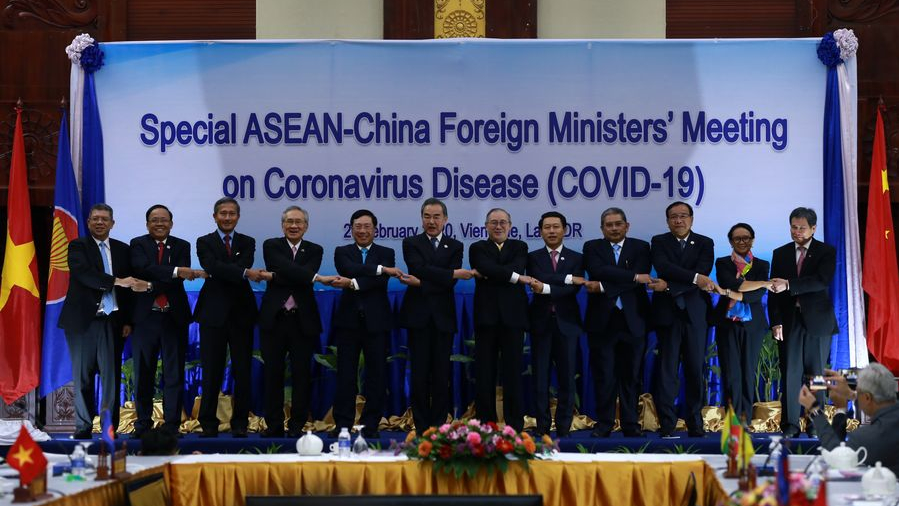
Chinese State Councilor and Foreign Minister Wang Yi (L6) and foreign ministers of ASEAN countries attend the Special ASEAN-China Foreign Ministers' Meeting on Coronavirus Disease in Vientiane, Laos, Feb. 20, 2020. /Xinhua
Chinese State Councilor and Foreign Minister Wang Yi (L6) and foreign ministers of ASEAN countries attend the Special ASEAN-China Foreign Ministers' Meeting on Coronavirus Disease in Vientiane, Laos, Feb. 20, 2020. /Xinhua
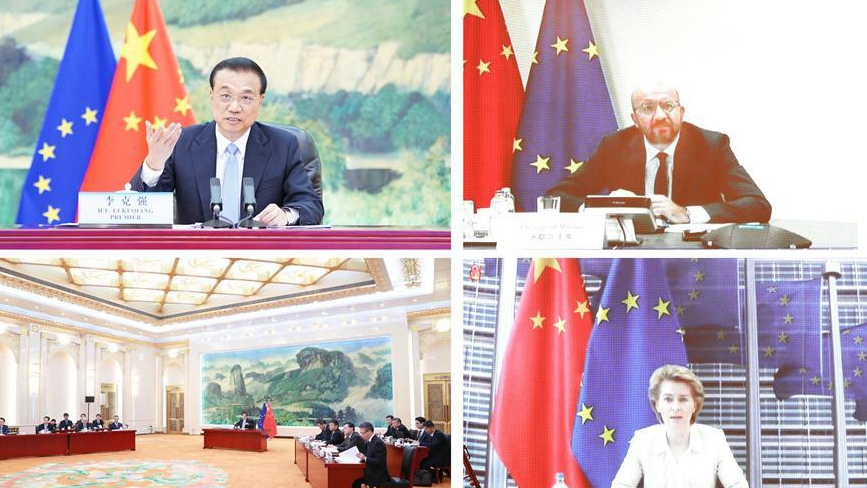
Leaders from China and the European Union (EU) affirm their commitment to expanding economic ties through closer cooperation, June 22, 2020. /Xinhua
Leaders from China and the European Union (EU) affirm their commitment to expanding economic ties through closer cooperation, June 22, 2020. /Xinhua
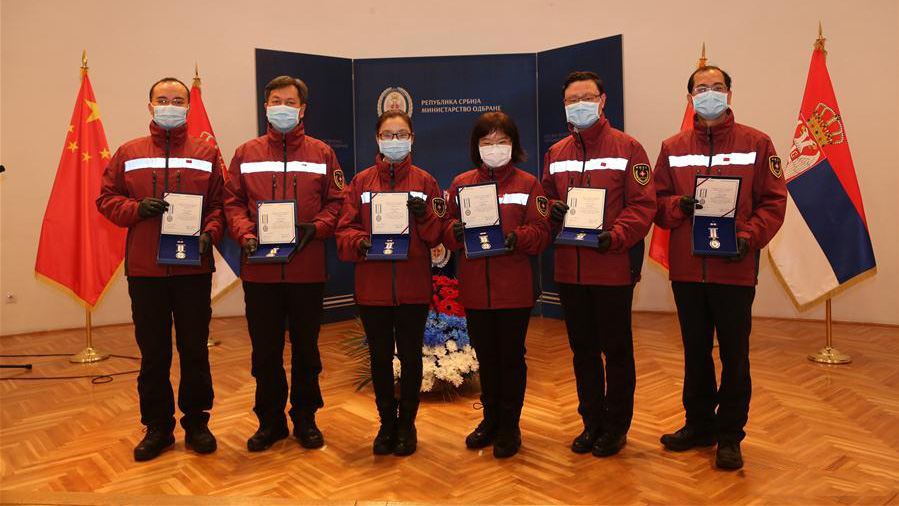
Serbia awards six Chinese medical experts with the Serbian army's most prestigious military honor for their contribution in the COVID-19 fight, April, 30, 2020. /Xinhua
Serbia awards six Chinese medical experts with the Serbian army's most prestigious military honor for their contribution in the COVID-19 fight, April, 30, 2020. /Xinhua
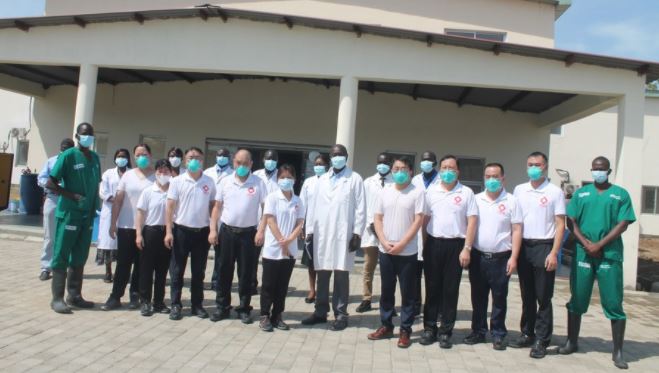
Members of Chinese medical expert team sent by the Chinese government to South Sudan pose for a photo with local frontline health workers at South Sudan's main COVID-19 treatment center in Juba, South Sudan, on August 21, 2020. /Xinhua
Members of Chinese medical expert team sent by the Chinese government to South Sudan pose for a photo with local frontline health workers at South Sudan's main COVID-19 treatment center in Juba, South Sudan, on August 21, 2020. /Xinhua
By April 12th, Chinese President Xi Jinping held meetings or talks with Prime Minister of Cambodia, President of Mongolia, President of Pakistan and Director-General of the WHO.
He had over 35 phone calls with over 30 leaders of countries and international organizations, including Russia, the United States, the United Kingdom, France, Germany, Italy, Spain, Belgium, the Republic of Korea (ROK), South Africa, Ethiopia, Brazil, and Chile, and Secretary-General of the United Nations.
He also sent messages of sympathy to more than 10 foreign leaders and heads of regional organizations, including the ROK, Italy, Iran, France, Germany, Spain, Serbia, and the European Union.
At the most trying stage of China's fight against the outbreak, leaders of over 170 countries and 50 international and regional organizations and more than 300 foreign political parties and organizations offered solidarity and support to Chinese leaders through letters, phone calls, and statements.
International organizations – the WHO, the G20, the Association of Southeast Asian Nations (ASEAN) and more, have also joined hands to prevent and control the spread of the virus.
What does 'community of shared future for mankind' mean?
"The global pandemic of COVID-19 has compounded the once-in-a-century changes unfolding in our world. It has affected every aspect of our life and reminds us once again that the wellbeing and future of all countries are interconnected," said Chinese State Councilor and Foreign Minister Wang Yi in his keynote speech at the International Seminar on the 75th Anniversary of the United Nations.
Why the concept should be promoted?
Besides the global health crisis, the world is made more complicated by challenges ranging from regional conflicts, terrorism and social disruptions to economic downturns, climate change and unbalanced development.
Where will the world go? Where is the path to development? For years, the vision for a community with a shared future for mankind has grown mature, gaining global resonance and becoming a strong voice in a changing world.
To forge this community, the UN has an irreplaceable role to play.
The first time this concept was officially presented to the international community was at the UN Headquarters in New York in 2015, when the Chinese president delivered a keynote speech on the term, extending it to all mankind.
"Let us unite ever more closely to create a new mutually beneficial partnership and community of shared future for mankind. Let the vision of a world free of war and enjoying lasting peace take root in our hearts. Let the aspirations of development, prosperity, fairness and justice spread across the world!" said the Chinese president.
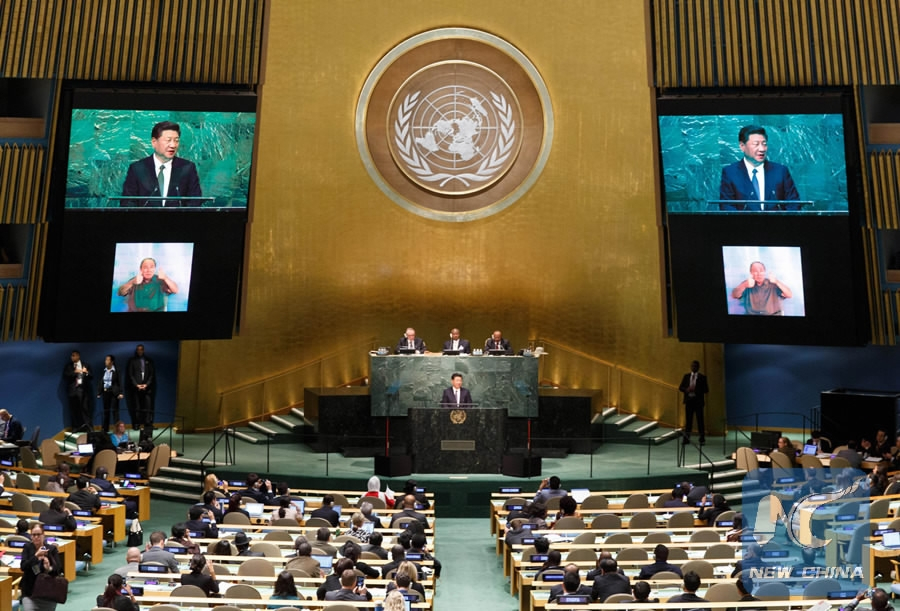
Chinese President Xi Jinping addresses the UN Sustainable Development Summit 2015 at the UN headquarters in New York, September 26, 2015. /Xinhua
Chinese President Xi Jinping addresses the UN Sustainable Development Summit 2015 at the UN headquarters in New York, September 26, 2015. /Xinhua
On February 10, 2017 at the 55th session of the UN Commission for Social Development (UNCSD), the concept was first adopted into an official UN document and on November 1, 2017, the Committee of Disarmament and International Security of the 72nd Session of UN General Assembly approved two draft resolutions that both incorporated the concept.
The UN Secretary-General Antonio Guterres said he regards China as "a strong pillar of multilateralism" and he recognizes the aim of multilateralism is to build a "shared future."
As the Position Paper of China on the 75th Anniversary of the UN said, the 75th anniversary of the UN presents important opportunities to renew the founding mission of the UN, forge international consensus on building a community with a shared future for mankind, and build an open, inclusive, clean and beautiful world that enjoys lasting peace, universal security and common prosperity.